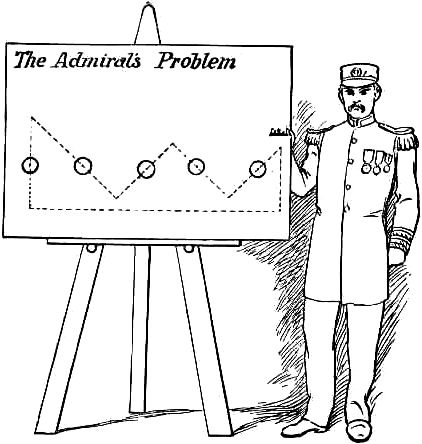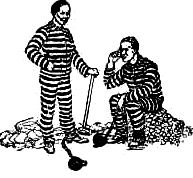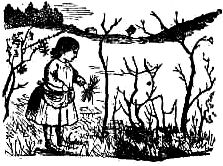



Admiral Togo is showing how a battleship might pass through the exact center of the five rings and back to the starting point in just seven straight moves. But the admiral tells his class in naval strategy that the feat can be done in less than seven moves. The puzzle, therefore, is to show in how few straight marks the trick can be done.
The Admiral shows how he sank the five battleships in four rushes:

Observe that one of the circles is purposely out of alignment.
2. An Illustrated Proverb.

Here is some valuable advice in pictorial form; the longer it takes you to guess it the better it will be impressed upon your memory.
“In haste accuse no man.”
3. A Rebus
My first mounts high when low you sleep;
My second’s found within the deep;
And should you wish my whole to see,
You'll find it perched on yonder tree.
Cipher Answer. ‚Ä” 19. 20, 1, 18, 12, 9, 14, 7.
STARLING
4. A Rebus
My first a useful barrier is
My next from harm to keep;
My whole upon some ruined tower
Does through the night watch sleep.
Cipher Answer. ‚Ä” 23, 1, 12, 12, 6, 12, 15, 23, 5, 18.
WALLFLOWER
5. Mandy’s joke

“How you was, Mr. Rastus Johnsing? Late spring we am havin’.” “Dat’s so, Mandy; when de sausage comes out of its hole and sees his shadow, he goes back for another nap. "
“Don't know what yo‘ talkin’ 'bout, [...] it’s de ground hog what looks at his shadder.”
“That's what I said, Mandy; isn't sausage ground hog?”
“You think yerself mighty smart, Mister Johnsing. I thought you were dead gone on chicken, but I guess it's for __________.” Give the name of the animal that will complete this sentence.
Mandy’s joke on Mr. Johnsing was “Pork-you-pine.”
6. Fun at Sing Sing.

Two pals who did “pick it” duty (oakum) at Sing Sing evolved the following problem: “If you gave forty seven cents for one hundred apples, and sold them for seventy cents, what percent profit would you make on your investment?”
The pals at Sing Sing go by their numbers and not by their names, so if you gave “Forty’' seven cents for the apples and sold them for seventy you would make 900 percent.
7. Picture Puzzle

There is no such thing as a bad puzzle, for everything that incites interest and amuses is useful, as it trains the youthful mind to concentrate; but of all the styles of puzzles, pictures which conceal objects possess the least known merit. I do not know as they teach anything. Nevertheless. I recall some pleasant moments spent over this old puzzle long, long ago. How we little ones used to delight to show it to visitors and ask. “Can you tell who Fannie is offering the hay to?”
Fannie is evidently offering hay to that cow, outlined in the picture.
The Rebus Puzzle advises you to “be independent, but not too independent.”
[Page 56]
